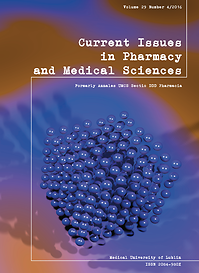Factors determining healthy work conditions in the beauticians’ workplace
DOI:
https://doi.org/10.1515/cipms-2016-0006Keywords:
beauty studio, hygiene requirements, healthy work conditionsAbstract
The beauty studio is a place of work where a beautician and her customers spend several hours, hence, it has to meet certain basic hygiene requirements so as to provide employees and customers conditions that keep them safe and healthy. The main dangers to which beauticians are exposed, are of physical, chemical, biological and psychophysical nature. Therefore, it is important to draw employees’ attention to the possible effects of the particular dangers and risks that come about when there is lack of the use of appropriate preventive measures.
References
1. Bilski B., Marynowicz B.: Knowledge and hygienic behaviour, as well as the risk of incidents posing a risk of hematogenous infection within a selected population of personnel of beauty and hairdresser’s studios. Med. Pr., 57, 517, 2006. (in Polish).
2. Braun-Falco O., Plewig G., Wolff H.H., Burgdorf W.H.C. (2004) Dermatology. Wydawnictwo Czelej, Lublin. (in Polish)
3. Council Directive 98/24/ EC of 7 April 1998 on the protection of health and safety of workers from the risks related to chemical agents at work. Official Journal No L 131, 5.5.1998, p.11–23.
4. Dylewska-Grzelakowska J. (2013). Applied Cosmetics. WSiP, Warszawa. (in Polish).
5. Fraise A. P., Lambert P. A., Maillard J.-Y. (2004) Russell, Hugo & Ayliffe’s principles and practice of disinfection, preservation and sterilization. Wiley Blackwell.
6. Górska E.: (2000) Ergonomic diagnosis of workplaces. Oficyna Wydawnicza Politechniki Warszawskiej, Warszawa. (in Polish).
7. Jakubowski M.: Documentation of limits of occupational exposure values. Podstawy i Metody Oceny Środowiska Pracy 47, 109, 2006. (in Polish)
8. Kanerva L., Elsner P., Wahlberg J., Maibach H. I., editors (2004) Condensed Handbook of Occupational Dermatology. Springer-Verlag Berlin Heidelberg.
9. Kieć-Świerczyńska M., Chomiczewska-Skóra D. Świerczyńska-Machura D. Kręcisz B.: Manicurists and pedicurists as a professional group with a significant risk of work-related dermatoses. Med. Pr., 64, 579, 2013. (in Polish)
10. Kurpiewska J., Liwkowicz J.: The efficacy of skin protection applied by beauticians. Bezpieczeństwo Pracy. Nauka i Praktyka, 2, 12, 2003. (in Polish)
11. Kurpiewska J., Liwkowicz J.: Skin protection – definitions, types, application, risk assessment and applicable legal regulations in Poland. Bezpieczeństwo Pracy. Nauka i Praktyka, 6, 23, 2010. (in Polish)
12. Murawska-Ciałowicz E. Zawadzki M. (2005). Hygiene. Górnicki Wydawnictwo Medyczne, Wrocław. (in Polish)
13. Regulation of the Minister of Health of 30 December 2004 on health and safety related to occurrence of chemical agents at work. Dz. U. z 2005 r., Nr 11, poz. 86. (in Polish).
14. Regulation of the Minister of Health of 17 February 2004 on specific sanitary requirements to be met by hairdresser’s, cosmetic, tattoo and wellness studios. Dz. U. z 2004 r., Nr 31, poz. 273. (in Polish)
15. Regulation of the Minister of Health of 22 April 2005 on the harmful biological factors for health in the workplace and on protecting the health of workers occupationally exposed to these factors. Dz. U. z 2005 r., Nr 81, poz. 716. (in Polish)
Downloads
Published
Issue
Section
License
Copyright (c) 2016 Authors

This work is licensed under a Creative Commons Attribution-NonCommercial-NoDerivatives 3.0 Unported License.


